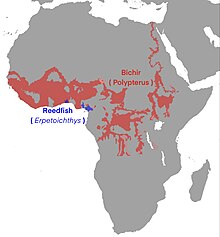Bichir
| Bichir Temporal range:
| |
|---|---|

| |
| Nile bichir Polypterus bichir | |

| |
| Barred bichir Polypterus delhezi
| |
| Scientific classification | |
| Domain: | Eukaryota |
| Kingdom: | Animalia |
| Phylum: | Chordata |
| Class: | Actinopterygii |
| Subclass: | Cladistia |
| Order: | Polypteriformes Bleeker, 1859 |
| Family: | Polypteridae Bonaparte, 1835 |
| Type species | |
| Polypterus bichir Lacépède,1803
| |
| Genera | |
|
| |

| |
| Red: Erpetoichthys extant
| |
Bichirs /ˈbɪʃɪərz/ and the reedfish comprise Polypteridae /pɒlɪpˈtɛrɪdiː/, a family of archaic ray-finned fishes and the only family in the order Polypteriformes /pəˈlɪptərɪfɔːrmiːz/.[2]
All the
Cladistia, polypterids and their fossil relatives, are considered the sister group to all other extant ray-finned fishes (Actinopteri).[3][4] They likely diverged from Actinopteri at least 330 million years ago. A closely related group, the Scanilepiformes, are known from the later Permian to the Triassic, and are likely ancestral to polypterids. The oldest polypterids are around 100 million years old, from the early Late Cretaceous of South America and Africa.[5][6][7]
Anatomy
Polypterids are elongated
Polypterids have a maximum body length ranging from 25 cm (9.8 in) to over 100 cm (39 in) depending on specific species and morphology.[12]
Diet and traits
Polypterids are nocturnal and feed on small vertebrates, crustaceans, and insects.[1] Their common aquarium diet includes bloodworms (Chironomidae larvae). Polypterids are known to have extraordinary olfactory ability.[citation needed] Polypterid reproduction consists of the female laying anywhere from 100 to 300 eggs over the span of a few days, and subsequent fertilization by the male.[13]
Air breathing
Polypterids possess paired
Polypterids as aquarium specimens
Polypterids are popular subjects of public and large hobby aquaria. They are sometimes called dragon bichir or dragon fin in pet shops for a more appealing name due to their dragon-like appearance. Though predatory, they are otherwise peaceful, preferring to lie on the bottom (they tend to swim when there are lots of large plants present), and make good tankmates with other species large enough to not be prey but small enough to not eat them. Some aquarists note that pleco catfish eat the slime coat off of polypterids. Polypterids in captivity have life expectancies of 10–30+ years. They do well in heavily planted tanks as it mimics their natural habitat.
Classification
In addition to the
| Phylogeny of Polypteridae.[3][4] | |||||||||||||||||||||||||||||||||||||||||||||||||||||||||||||||||||||||||||||||||
|



Order Polypteriformes
Suborder Polypterioidei
Clade Salamandrophysida
- Family Polypteridae
- Genus †Bawitius Grandstaff et al. 2012
- †Bawitius bartheli (Schaal 1984) Grandstaff et al. 2012 - Late Cretaceous (Cenomanian) of Egypt
- †
- Genus †Serenoichthys Dutheil 1999a
- †Serenoichthys kemkemensisDutheil 1999a
- †
- Genus Erpetoichthys J. A. Smith, 1865
- J. A. Smith, 1865 (reedfish)
- Genus Polypterus Lacépède, 1803
- †Polypterus dageti Gayet & Meunier 1996
- †Polypterus faraou Otero et al., 2006 — late Miocene[15]
- †Polypterus sudanensis Werner & Gayet 1997
- Retropinnis group
- Vaillant, 1899 (West African bichir)
- Bichir group
- Polypterus ansorgii Boulenger, 1910 (Guinean bichir)
- Polypterus bichir Lacépède, 1803 (Nile bichir)
- P. b. bichir Lacepède, 1803
- P. b. lapradei Steindachner, 1869
- P. b. ornatus Arambourg 1948
- Polypterus congicus Boulenger, 1898 (Congo bichir)
- Polypterus endlicheri Heckel, 1847 (saddled bichir)
- Weeksii group
- Polypterus mokelembembe Schliewen & Schäfer, 2006 (Mokèlé-mbèmbé bichir)
- Polypterus ornatipinnis Boulenger, 1902 (ornate bichir)
- Polypterus weeksii Boulenger, 1898 (mottled bichir)
- Senegalus group
- Polypterus delhezi Boulenger, 1899 (barred bichir)
- Polypterus polli J. P. Gosse, 1988
- Polypterus palmas Ayres, 1850 (shortfin bichir)
- P. p. buettikoferi Steindachner, 1891
- P. p. palmas Ayres, 1850
- Polypterus senegalus Cuvier, 1829 (gray bichir)
- P. s. meridionalis Poll, 1941 (most likely a variant of P. s. senegalus)
- P. s. senegalus Cuvier, 1829
- Polypterus teugelsi Britz, 2004 (Teugelsi bichir)
- Genus †Bawitius Grandstaff et al. 2012
References
- ^ ISBN 978-0-12-547665-2.
- ^ Helfman GS, Collette BB, Facey DE, Bowen BW. 2009. The Diversity of Fishes. West Sussex, UK: Blackwell Publishing. 720 p.
- ^ PMID 20624284.
- ^
- S2CID 8026535.
- S2CID 205259531.
- ^ Bakaev, A. S.; Kogan, I. (2022). "Squamation of the Permian actinopterygian Toyemia Minich, 1990: evenkiid (Scanilepiformes) affinities and implications for the origin of polypteroid scales". www.geology.cz. Retrieved 2024-02-28.
- ^ PMID 24451680.
- ISBN 0-12-093156-7
- ^ Innervation of lung and heart in the ray-finned fish, bichirs
- ^ AccessScience | Encyclopedia Article | Polypteriformes
- ^ a b Froese, Rainer, and Daniel Pauly, eds. (2023). "Polypteridae" in FishBase. October 2023 version.
- ^ "Breeding Bichirs". www.aquaticcommunity.com. Retrieved 2021-08-27.
- ^ a b Graham, J.B. 1997. Air-breathing Fishes: Evolution, diversity, and adaptation. San Diego: Academic Press. 299 p.
- .
